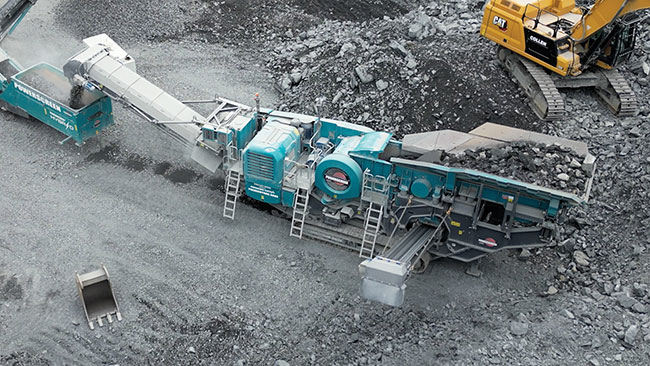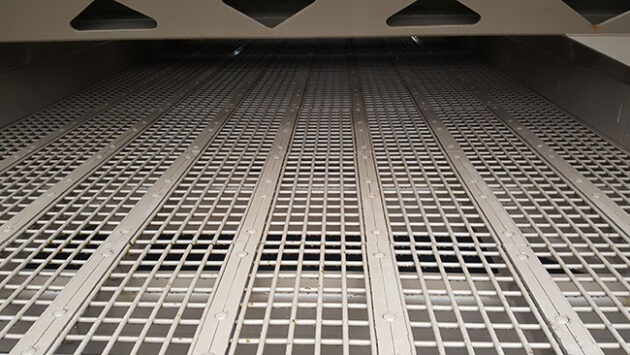
Features
Aggregates
Crushing Week
Pits & Quarries
Screening technology: customizable efficiency
Versatility is the key to the future of screening
August 1, 2023 By Elizabeth Bate
 The Powerscreen lineup from Terex is working to be emission-friendly.
The Powerscreen lineup from Terex is working to be emission-friendly. Screening aggregate is a noisy, dirty job. Screeners develop wear and tear, material gets stuck in places you’d rather not think about, and the downtime can seem to go on forever. It’s not always ideal, but what else is there? Historically, screening has been seen as a system where not much development can be done, or so you might imagine.
If you’re currently running and repairing decades-old screening equipment, like many operators, you might not be aware of the advancements screening technology is making.
The latest developments can reduce downtime, make maintenance and repair easier and save your operation money.
If it’s time to look for something new, you may be surprised at how far screening equipment has come. This month, Rock to Road has the rundown on all the new features to look for.
The future is electric
While electric machines are the standard for stationary screens, until recently the feature has been harder to find on mobile units, which typically operate using a diesel hydraulic system.
With no end in sight for rising fuel prices, running a full day on diesel can be a major expense. Darryl Steen, a mobile equipment specialist with Frontline Machinery, says bringing electricity to mobile units represents a huge advancement in technology.
“The biggest thing, the most exciting thing, is electrification. Most of the mobile [units] typically have always been diesel hydraulic, which is inherently inefficient,” he said. “Even a mid-sized machine running four to five litres of fuel an hour, costed out over 10,000 hours of use, and that’s a pretty serious number.”
Steen estimates that running the screener off electricity, even if it’s plugged into other equipment running diesel, saves a minimum of 30 per cent in fuel burn.
“That’s real money, that’s real dollars.”
While creating new machines to be more economical and efficient is the primary concern of manufactures, Ciarán Fanning, director of engineering for Terex says incoming legislation is another concern.
“Obviously diesel creates a lot of carbons and a lot of nasties and there’s a lot of countries and regions trying to get rid of diesel engines and diesel screens. A big focus for us, is how we move to an alternative power supply,” he said.
While the majority of regulations restricting or banning diesel engines are currently in Europe, as Canada moves towards its net-zero goals, emission-friendly equipment may be the way to go. Electric mobile equipment can help take a site from emission-heavy to emission-light by being a primary power source for other equipment.
New electric and electric-hybrid mobile machines not only have the ability to plug into line power on electrified sites, something Steen calls the ultimate situation, but they can plug into generators or other equipment on sites that don’t have the same kind of power.
The reverse is true as well, allowing other equipment to be plugged into the electric mobile machines, making it possible to power nearly an entire site off the mobile screening unit.
That customizable flexibility allows operators to run the equipment in the most economical way possible without having to worry about how they’re going to power their machines.
Flexibility is a theme with newer equipment, allowing individual customization across a number of features.
Just like Lego
When it comes to screen media, Alex Caruana, national manager – Canadian aggregates, with Polydeck, says the old way of doing things meant if a machine came set up for a single kind of media, owners could be stuck with what they were given.
“The old way of doing things if your screen came set up for wire cloth, you were a bit hampered. Without a great deal of effort, you were kind of stuck there,” he says.
In order to change the type of screening material to make it more efficient, a lot of downtime and expense was needed.
Now, the latest machines can be set up to receive different types of screening material, right where it’s needed most.
“Hybridization is the latest thing. It’s been building over the last couple of years or so, but it’s at the point where there is little we cannot do,” Caruana said. “What a lot of operators are looking at in terms of hybrid screens is choosing the exact, correct blend to put the purpose-built media in the exact right parts of each screen.”
This hybrid technique means operators can not only swap out different types of screening material as they need to, but that they can use two or more types of material at the same time, in different areas of the machine. The heavier duty items can be placed where the most impact resistance is needed, and lighter duty items can be used where more throughput is needed on a screen.
This kind of hybrid system can be requested through an OEM when a machine is being ordered initially, saving time and money down the road.
“A lot of producers are realizing that outfitting a screen with a hybrid system right off the hop, by requesting it through their OEM, although a little bit more costly initially, it is the way to go because then you can use whatever you want,” Caruana says.
“It becomes plug and play then, it’s like putting a Lego set together. You pick exactly where you want each piece.”
Another advantage modular has over classic is being able to replace material with more efficiency and less downtime as it wears out.
“When you burn out a small section, all of a sudden, you send one human being into that machine, they change that one or two sections and then they’re back out… and the thing’s ready to rock and roll again.”
Modular paneling can help increase the longevity of a piece of equipment too, making it possible to balance media easier, Caruana says.
“I can’t sermonize enough about balancing the media on the deck and protecting the subframe,” he said.
That includes putting “high open area panels where you need them, high life panels where you need them. You can do it, it may take a little bit of upfront effort, but you can do it to the point where you reduce your failure cycles.”
Reducing failure cycles helps to reduce unplanned downtime, saving sites money and hassle.

The Polydeck Metaldex.
Alerted before there’s a problem
Thomas Jordan, Technical Sales Manager for Wirtgen America says Kleemann’s integrated telematics systems aim to reduce downtime by letting operators know there might be an issue sooner, allowing them to take care of it before it becomes a major problem.
“On our portable screening equipment, we call it interlinking,” he said.
The screener will communicate with the equipment in front of it or behind it, through wireless technology, so it becomes an integrated part of a complete operating system.
“With the new wireless technology, it’s linking into the machine downline and once it detects a buildup of material or something out of the normal, it’ll actually slow itself down,” Jordan says. “So, it’s constantly monitoring itself and the units ahead of it and behind it. They aren’t operating as individual units, they’re all working together.”
That monitoring allows the machine to keep from overloading and getting blocked, reducing the amount of time it takes to clear the system and get back to normal.
While systems like Kleemann’s allow operators to reduce unplanned downtime, Caruana says planned downtime may be the key to keeping machines running longer and more efficiently.
Maintenance is key
Daily, weekly and monthly checklists are important to keeping a machine running and sites should be ensuring they’re completed, even if it takes a little extra time at the beginning and end of each day.
In addition to regular checklists, deeper inspections are necessary a couple of times a year. With supply chains still experiencing slowdowns, Caruana says the key to longevity and reduced downtime is regular overall health checks, so problems can be caught while they’re still repairable on site.
“A lot of operators are very good at bearing maintenance, motor maintenance and so on, but there’s nobody crawling through that machine to inspect their deck frames, their feed boxes, and some of these things that may not be super visible from outside of the machine,” he said.
If operators don’t have someone on site to inspect the machine more thoroughly, OEM and product sales reps may be able to provide someone to help complete larger scheduled maintenance tasks, like a walkthrough.
“It’s very worthwhile to get someone to come in at five or six in the morning, before you start up, lock out of the machines, go through and then talk about what needs repair or replacement.”
Those walkthroughs could save a machine that may otherwise be a victim of supply chain backups. With some reports saying it could be up to a year for some parts to come in, regular inspections are a life-saving operation for some sites.
If you’re not replacing your equipment this year, or you’re looking to preserve the health of your new equipment, regular maintenance and scheduled downtime are crucial to making sure equipment stays in top shape.
Print this page